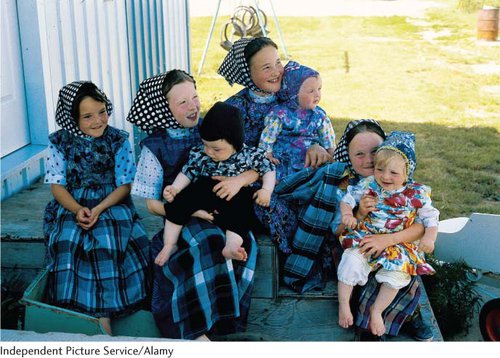From DNA to Proteins: Translation
Hutterites, Ribosomes, and Bowen–Conradi Syndrome

The Hutterites are a religious branch of Anabaptists who live on communal farms in the prairie states and provinces of North America. A small number of founders, coupled with a tendency to intermarry, has caused a high frequency of the mutation that results in Bowen–Conradi syndrome among Hutterites. Bowen–Conradi syndrome results from defective ribosome biosynthesis, affecting the process of translation. Shown here are healthy Hutterite children.
[Independent Picture Service/Alamy.]
The essential nature of the ribosome—the cell’s protein factory—is poignantly illustrated by children with Bowen–Conradi syndrome. Born with a prominent nose, a small head, and an unusual curvature of the little finger, these children fail to thrive and gain weight, usually dying within the first year of life.
Almost all children with Bowen–Conradi syndrome are members of the Hutterites, a branch of the Anabaptist religion that originated in the 1500s in the Tyrolean Alps of Austria. After years of religious persecution, the Hutterites emigrated to South Dakota in the 1870s and subsequently spread to the neighboring prairie states and Canadian provinces. Today, the Hutterites in North America number about 40,000. They live on communal farms, are strict pacifists, and rarely marry outside of the Hutterite community.
Bowen–Conradi syndrome is inherited as an autosomal recessive disorder, and the association of this syndrome with the Hutterite community is a function of the group’s unique genetic history. The gene pool of present-day Hutterites in North America can be traced to the fewer than 100 persons who immigrated to South Dakota in the late 1800s. The high incidence of Bowen–Conradi syndrome in Hutterites today results from the founder effect—the presence of the allele that causes the syndrome in one or more of the original founders of the population—and from the spread of that allele as Hutterites intermarried within their community. Because of the founder effect and inbreeding (see Chapter 18), many Hutterites today are as closely related as first cousins. This close genetic relationship among the Hutterites increases the probability that a child will inherit two copies of the recessive allele and have Bowen–Conradi syndrome; indeed, almost 1 in 10 Hutterites is a heterozygous carrier of the allele that causes the disease.
Although Bowen–Conradi syndrome was first described in 1976, the genetic and biochemical basis of the disease long remained a mystery. After a seven-year quest to find the causative gene, researchers at the University of Manitoba determined, in 2009, that Bowen–Conradi syndrome results from the mutation of a single base pair in the EMG1 gene, located on chromosome 12.
The discovery of the gene for Bowen–Conradi syndrome provided immediate insight into the biochemical nature of the disease. Although little is known about the function of EMG1 in humans, earlier studies in yeast revealed that it encodes a protein that helps to assemble the ribosome. As we saw in Chapter 10, the ribosome is composed of small and large subunits. The small subunit in humans consists of a single molecule of rRNA, known as the 18S rRNA, and a large number of proteins. The protein encoded by the EMG1 gene plays an essential role in processing the 18S rRNA and helps assemble it into the small subunit of the ribosome. Because of a mutation in the EMG1 gene, babies with Bowen–Conradi syndrome do not produce a normally functioning ribosome, and the process by which all proteins are synthesized is affected.
Page 290
Bowen–Conradi syndrome illustrates the extreme importance of translation—the process of protein synthesis—which is the focus of this chapter. We begin by examining the genetic code—the instructions that specify the amino acid sequence of a protein—and then examine the mechanism of protein synthesis. Our primary focus will be on protein synthesis in bacterial cells, but we will examine some of the differences between bacterial and eukaryotic cells. At the end of the chapter, we will look at some additional aspects of protein synthesis.
